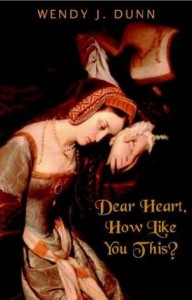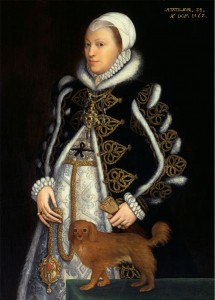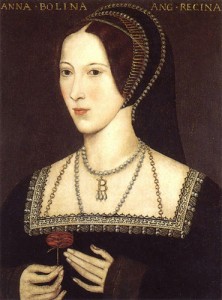SPEAKING THE SILENCES: WRITING, ADVOCACY AND ENABLING VOICE – An extract from Wendy’s paper for the refereed proceedings of the 16th annual AAWP conference, Ethical Imaginations: Writing World.
The full paper can be found here:
Biographical note:
Wendy J. Dunn is obsessed with Tudor History. Her first published novel, the award-winning Dear Heart, How Like You This? is described as ‘one of the best novels ever written about Anne Boleyn’s life’. After completing her Masters in Writing at Swinburne University in 2009, Wendy took up a position as a sessional tutor in the same course and became a PhD Candidate. Her own writing journey continues.
Historical Fiction and Advocacy
Historical fiction is a multifaceted and demanding genre with complex ethical considerations for the writer to surmount. As Jonathan Nield writes in his 1902 Guide to the Best Historical Novels and Tales,
The spirit of a period is like the selfhood of a human being – something that cannot be handed on; try as we may, it is impossible for us to breathe the atmosphere of a bygone time, since all those thousand-and-one details which went to the building up of both individual and general experience, can never be reproduced’ (Nield 1902: 41).
The reasons writers use this genre for their fictional expression are also complex and position works within an ethical framework. Writers like Flaubert and Tolstoy used their historical novels as ‘experiments and crucial inventions in important cultural debates’ (de Groot 2009: 2).
Other writers beside myself write historical fiction because of passion and advocacy. Sandra Worth writes historical fiction because ‘a historical figure will leap off the page into my heart. I feel compelled to give them voice, to tell their story, to let them speak and live again in the hope that others will come to care, and they won’t be forgotten’ (Worth 2011).
Historical fiction became my means to combine my two lifelong passions: writing and learning about the Tudors. The artefact for my PhD is my third Tudor novel after the 2002 publication of Dear Heart, How Like You This? – my first major Tudor work. This time, I have chosen to convey the metaphysical period of the Tudors by experimenting with magic realism.
I use Tudor England as the setting for my novels and explore the lives of Tudor women, in particular, six women who lived their lives close to one Tudor monarch. Many popular authors serve this popular genre and also write about these women: Phillipa Gregory (The Constant Princess, 2006; The Other Boleyn Girl, 2004; The Boleyn Inheritance, 2008), Hilary Mantel (Wolf Hall, 2010), Robin Maxwell (The Secret Diary of Anne Boleyn, 1998; Mademoiselle Boleyn, 2007), just to name a few.
It is clear the six wives of Henry VIII continue to mesmerize the imagination of female writers. That is not surprising. The marital exploits of Henry VIII provide great, multilayered story fodder for writers and readers. Adultery, murder, lust, love, passion, tragedy, sorrow, triumph, ambition and pride – it is all there and speaks to our shared humanity and lives as women.
I as a fiction writer wish to advocate for my female main characters, characters who were also people in their own right. I feel ethically compelled to take up the cry for justice I hear in the poem believed written by Anne Boleyn waiting for death in the Tower:
Defiled is my name full sore
Through cruel spite and false report,
That I may say for evermore,
Farewell to joy, adieu comfort.
For wrongfully you judge of me
Unto my fame a mortal wound,
Say what ye list, it may not be,
Ye seek for that shall not be found (Bailey-Kempling 1908).
I started my PhD artefact, Light in the Labyrinth, because, similar to other writers, I see writing fiction as a way to gain knowledge (Tremain cited by de Groot 2010: 100–1) – about the Tudors, about life, and about myself.
Writing Dear Heart, How Like You This? created more questions for me, especially about the events leading up to Anne’s death in 1536. Why did Henry turn against Anne Boleyn so fatally? Believing by writing I would illuminate a possible answer, I decided to take up the challenge of another Tudor novel focusing on the fall of Anne Boleyn, but this time target my work to the Young Adult reader. I especially want to be fair and just to Henry VIII in my new work. After writing two novels about his first two queens, I recognised that my point of view was biased towards his wives.
My artefact enables the voice of Katherine Carey, the niece of Anne Boleyn. History only provides a few bones of her story added to a number of paintings identified as or believed to be Katherine Carey. She is one of those obscure lives described by Woolf as ‘fitfully perceived’ ‘in those almost unlit corridors of history’ (Hale 2006: 580). By reconstructing her life in fiction I return herstory (Kon-yu 2011).
Enabling Katherine’s voice has brought with it particular ethical challenges. With all historical fiction, research is the key to the reconstruction of a period and understanding how character is shaped in a time not our own. Recreating historical characters not only entails the necessary research that enables the writer to ‘construct a world’ (Eco 2005: 311), but also to appreciate that ‘(y)our characters are who they are because they enter that herstory (my italics) stream when and where they do’ (Thom 2010: 52).
The Silence of Tudor Women
The patriarchal society of the Tudors told women silence was a virtue, and the only form of eloquence appropriate to women (Jordan 1990: 173). From high to low, women who did try to make their voices heard put themselves into the dangerous position of nonconformity. They risked physical punishment, if not their lives. Women, like Anne Boleyn, could even be accused of witchcraft if they refused silence. Indeed, there are English pubs that once served to remind women about what could happen if they forgot to bridle their tongues. Named as Quiet Woman or Silent Woman, the pubs often brandish a couplet, a couplet that seems related to Anne Boleyn:
Here is a woman who has lost her head
She’s quiet now—you see she’s dead (Rothwell 2006: 354).
With silence a matter of life or death, it is not surprising the Tudor period left women historically voiceless. Their stories often erased, their portraits identified as unknown, the lives of women were also left little more than a footnote to, if not just only filtered, through the lives of men (Kon-yu 2011).
I argue that while history does provide documentary evidence for the voices of Tudor women, especially those in the foreground of history, these voices, in most instances, are of the silenced. But women found ways of empowerment, and ‘the possibility of a voice’ (Heale 1995: 305). Writing was an uncommon skill of noble women and men (Harris 2002: 35), yet three or more of the women I am using as characters in my work historically came together to write in what is now known as the Devonshire Manuscript. In this small manuscript, the women copied poems or songs, or sometimes wrote their own works. Adding their voices alongside men, they did not lack courage to speak up to them (Heale 1995: 303).
Nevertheless, Tudor women were not brought up to see themselves as equal to men (Sim 1996: 33). Elizabeth I, the intelligent and gifted daughter of the intelligent and gifted Anne Boleyn, apologised for her femaleness, referring to herself as ‘Prince’ on many occasions during her long reign as Queen. Thus, historical record makes it apparent that women’s voices were, more often than not, couched and constrained in a manner that reflected back their prescribed role in their society (Heale 1995: 297).
Another example comes from the life of Katherine of Aragon (Mattingly 1942; Luke 1967; Fraser 1993; Paul 1966; Weir 2002; Starkey 2003). For almost twenty years of her long marriage to Henry VIII we hear little from her, other than as an obedient and gently speaking King’s consort who knew her place and purpose. She did not hide her distress about his unfaithfulness in the early years of their marriage or when he made a duke of his bastard son, but the distress was soon put aside in compliance to his wishes and desires. Katherine lived up to her motto: Humble and Loyal, and spent many years of her marriage being so.
Anne Boleyn was less humble. When she protested about Henry VIII’s unfaithfulness during their marriage, he told her bluntly, ‘(s)he must shut her eyes and endure just like others who were worthier than she’ (Ives 2004: 192). It is obvious Henry VIII was referring to Katherine, a woman trained to be queen from early childhood. However, when Katherine of Aragon’s marriage was threatened we hear the real Katherine, a woman no longer willing to endure but determined to fight:
This twenty years or more I have been your true wife, and by me ye had had divers children, although it hath pleased God to call them from this world…And when you had me at the first, I take God to be my judge, I was a true maid, without touch of man (Sylvester, Harding et al. 1962: 149–150).
Whilst Katherine’s words ring true, researching the period, there have been countless other times when the documented words of Tudor women spoke to me of silence. Through similar, but more liberated life experience, I recognised women carefully weighing up their words, making them palpable and acceptable to men. What is hidden in the voices of Tudor women is revealed to the astute reader by the eluded and alluded (Arnold 2011). Contradictions and erasures also provide evidence of disjointed or incomplete narratives (McNay 2009). Enabling these voices is what I see as my duty as a historical fiction writer. The silence imposed on Tudor women demand advocacy and stories from me.
Anne Boleyn, the Anomaly
My PhD artefact enables the voice of Anne Boleyn and her niece, Katherine Carey. I shall let my imagined Anne begin this section:
‘Much of this is my own fault; I lack a woman’s proper humility and have a temper difficult to rein in at times.’ The queen smiled bitterly. ‘I speak my mind, niece. For years, the king valued and sought for my counsel, but no more. He desires my silence, but how I can be so when I have spent years being otherwise? Once abandoned, silence is a difficult art to relearn’ (xxxx 2011)
Anne Boleyn, the second wife of Henry VIII, provides us with an anomaly when it comes to the lives of Tudor women. Perhaps this explains why I and at least fifteen other writers have been drawn to her story (de Groot 2009: 75). Anne Boleyn was a woman who rejected silence, and paid the ultimate price for doing so. By rejecting silence she gave to the period an authentic voice of a woman who was heard; a voice that now transcends time. My research has never given me cause to doubt her innocence, or changed my view about the injustice of her death. Research has only increased my respect for Anne Boleyn and cemented my desire to act as her advocate. But, as a writer, to fulfil my ethical position of advocacy and enable Anne Boleyn’s voice, I must first take ownership of my subject through thorough study.
History shows Anne’s death came about not simply because she failed to provide Henry VIII with a son but because of a heady mix of politics and religion (Ives 2004: VI) one and the same in the Tudor period.
Early in 1536 Henry VIII and the then pregnant Anne Boleyn celebrated the death of Katherine of Aragon. Part of the festivities was a joust in which the king took part. He almost lost his life when his horse threw him. Unconscious for three hours, he appears a different man on his revival. The jousting accident was followed not long afterwards by the loss of his son sixteen-weeks into Anne Boleyn’s pregnancy. From that time to not long before her arrest, a period of about ninety days, as recounted by historian Alison Weir in The Lady in the Tower, history shows Henry VIII swinging one way to another in his relationship with his wife (Weir 2010).
Henry VIII is believed to have said, not long after Anne’s last abortive pregnancy, ‘seduced and forced into his second marriage by means of sortileges and charms’ (Warnicke 1987: 256). Anne Boleyn was no witch; rather a proud and intelligent woman who chose to disregard what was expected of her time. Determination to have her voice heard for the political and religious direction of England brought her to the time when Henry VIII chose to erase her from his life, persuaded that her lack of silence and self-effacement provided evidence of treason and lack of chastity. As Heale (1995) writes:
The dangerous tightrope courtly women had to tread between wit and scandal, pastime and offence is suggested by the daunting advice of Giuliano, in the Courtier: ‘And therefore muste she keep a certaine meane verie hard, and (in a manner) derived of contrary matters, and come just to certain limittes, but not to passe them’ (Heale 1995: 298).
I contend Anne’s drive to move towards a doctrine that saw no need for a go between God and man challenged the crown, and Henry, manipulated by Cromwell, convinced himself of the need to silence her voice and therefore erasing her from his life. No wise person dared to speak directly of Anne Boleyn to the king after her execution. The subject seemed ‘to have remained taboo’ (Weir 2010: 319). Only when Anne’s daughter Elizabeth was crowned queen, even if simply to rehabilitate the reputation of the queen’s mother (Freeman 1995: 798), were memories of Anne Boleyn given free voice again. My way to rehabilitate and give justice to Anne Boleyn’s memory is to enable her voice by fiction.
List of works cited:
Arnold, Josie 2011. ‘The liminal and apopahatic voice of the writer in/as autobiography: a subjective academic narrative.’ Text 14 (1) http://www.textjournal.com.au/april10/arnold.htm (accessed 4 July 2011).Bailey-Kempling (Ed.) 1908 The Poets Royal of England and Scotland: Kessinger Publishing
De Groot, Jerome 2009 The historical novel. London; New York, Routledge.
xxxx. 2002 Dear Heart, How Like You This?, Yarnell, AZ: Metropolis Ink.
xxxx. 2011 Light in the Labyrinth, Uncompleted PhD Artefact: Swinburne University.
Eco, Umberto 1994 The Name of the Rose; San Diego: Harcourt Brace.
Eco, Umberto 2005 On Literature, Orlando: Harcourt.
Emerson, Kathy 2008. ‘A WHO’S WHO OF TUDOR WOMEN: C-Ch http://www.katemersonhistorical.com/TudorWomenC-Ch.htm (accessed on 19/08/2011).
Fraser, Antonia 1992 The Six Wives of Henry VIII, London: Weidenfeld & Nicolson.
Freeman, T. S. 1995 ‘Research, Rumour and Propaganda: Anne Boleyn in Foxe’s Book of Martyrs’, The historical journal 38(4)
Froude, J. A. 1891 The Divorce of Catherine of Aragon; the story as told by the imperial ambassodors resident at the court of Henry VIII, London and New York: Longmans, Green and co.
Hale, D. J. 2006 The Novel: An Anthology of Criticism and Theory, 1900–2000, Malden, Mass.: Blackwell Pub.
Harris, Barbara J. 2002 English Aristocratic Women, 1450–1550: marriage and family, property and careers, New York: Oxford University Press.
Harris, Barbara J. 1989 ‘Power, Profit, and Passion: Mary Tudor, Charles Brandon and the Arranged Marriage in Early England’. Feminist Studies 1(Spring 1989): 59–87.
Heale, Elizabeth 1995 ‘Women and the Courtly Love Lyric: The Devonshire MS (BL Additional 17492),’ Modern Language Review 90.2: 296–313.
Heilbrun, Carolyn 1998 Writing a Woman’s Life: Ballantine.
Ives, E. W. 2004 The Life and Death of Anne Boleyn: ‘the most happy’, Malden, MA: Blackwell Pub.
Jordan, C. 1990 Renaissance Feminism: literary texts and political models, Ithaca, NY: Cornell University Press.
Kon-yu, N. 2011 ‘Letting go of the truth: researching and writing the other side of silence in women’s lives’ Text 14 U (2) http://www.textjournal.com.au/oct10/konyu.htm (accessed 2 July 2011).
Luke, Mary 1967 Catherine the Queen, New York: Coward-McCann
Mattingly, G. 1942 Catherine of Aragon, London: J. Cape.
McNay, Margaret. 2009 ‘Absent memory, family secrets, narrative inheritance’ Qualitative Inquiry 15.7: 1178–1188. General OneFile. (accessed 23 Sep. 2011).
Nield, J. 1902 A Guide to the Best Historical Novels and Tales, New York: London, G.P. Putnam’s sons; E. Mathews.
Paul, J. E. 1966 Catherine of Aragon and her friends, London: Burns & Oates.
Pulman, F. 2011 Email interview July 26.
Ray, M. K. 2004 V.S. Naipaul, Atlantic Publishers & Dist
Rothwell, D. 2006 Dictionary of Pub Names, Wordsworth Edition
Santanya, G. 1905 The Life of Reason (vol. 1), 1905.
Schulman, M. 2006 ‘Fiction and the Ethics of Writing’ at http://www.scu.edu/ethics/pubications/submitted/ron-hansen.html (accessed 16/08/2011).
Sim, A. 2001. The Tudor Housewife, Edition: McGill-Queen’s University Press.
Starkey, D. 2003 Six wives: the queens of Henry VIII, London: Chatto & Windus.
Sylvester, R. S., D. P. Harding, et al. 1962 Two early Tudor lives: The life and death of Cardinal Wolsey, New Haven: Yale University Press.
Thom, J. A. 2010 The art and craft of writing historical fiction, Cincinnati, Ohio: Writer’s Digest Books.
Varlow, S 2007 `Sir Francis Knollys’s Latin dictionary: new evidence for Katherine Carey’. Historical Research 80 (209): 315–323 (accessed August 9 2009).
Warnicke, Retha M. 1987 ‘Sexual Heresy at the Court of Henry VIII’ The Historical Journal Vol. 30, No. 2, Cambridge University Press, at http://www.jstor.org/stable/2639194 (accessed August 20 2011).
Weir, Alison 2002 Henry VIII: the king and his court, New York: Ballantine Books.
Weir, Alison 2010 The Lady in the Tower: the fall of Anne Boleyn, New York: Ballantine Books.
Worth, S. 2011 Email Interview July 26


















I just wrote a whole bunch of stuff but somehow mess up the captcah phrase. Suffice it to say, thank you for a great piece! Can’t wait for your new book. Sounds like we have some ideas in common
Thank you, Anne!